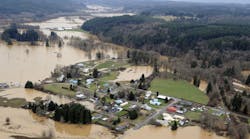Chesapeake Bay Watersheds Retrofitted for Storm Water Management
A few dozen runoff collection ponds built years ago in the Chesapeake Bay watershed are being retrofitted for storm water management, reported the Bay Journal.
Upgrades include equipping the collection ponds with real-time sensors and cloud-based controls, as they remotely release or retain storm water in response to online weather reports.
“It’s somewhat of a revolution,” said Tom Schueler, executive director of the Maryland-based nonprofit Chesapeake Stormwater Network.
For the last 30 to 40 years, engineers have been relying on gravity alone to capture and treat runoff, mainly to control flooding and stream erosion, reported the Bay Journal.
Runoff accounts for 16% of the nitrogen, 18% of the phosphorus and 24% of the sediment fouling the Bay, according to the state-federal Chesapeake Bay Program.
“A lot of the money we’re spending now is to fix the sins of the past,” said Bob Bathurst, a principal with Century Engineering, a Hunt Valley, MD, firm that works on smart ponds. “The stream channel erosion that’s ongoing, unless we control the runoff rate, we’re going to continue to have it.”
Actively managed smart ponds are capable of curbing the surge of runoff that erodes stream banks and can enhance the pollution-trapping performance of old storm water basins 25–50%. They can also reduce the frequency or severity of downstream flooding from intense rainstorms.
A sensor placed on the bottom monitors the water level, while an electronically activated actuator is used to open or close a butterfly valve installed in the pond’s water release outlet, reported the Bay Journal. A microcomputer connected to the internet then collects water-level and weather forecast data and manipulates the release valve.
The control system calculates the amount of runoff that is expected to flow into the pond. A signal is sent over the internet to open a valve at the pond up to 48 hours in advance of the precipitation and the pond level drops as the water is gradually released into a nearby tributary of the Gwynns Falls. This occurs until there is enough storage created in the basin to accommodate the projected accumulation without overflowing, reported the Bay Journal.
The status of the pond is monitored on a digital dashboard that can be accessed with a smartphone.
Sandy Hertz, assistant director of the Maryland Department office of environment, owns about 800 ponds that could be retrofitted. The agency has been waiting for state regulators to verify the technology’s effectiveness before taking the plunge with its own facilities, however.
The department announced a public-private partnership in November, where it pledged to pay $4 million to facilitate smart storm water ponds at four Wal-Mart and Sam’s Club stores across Maryland.


